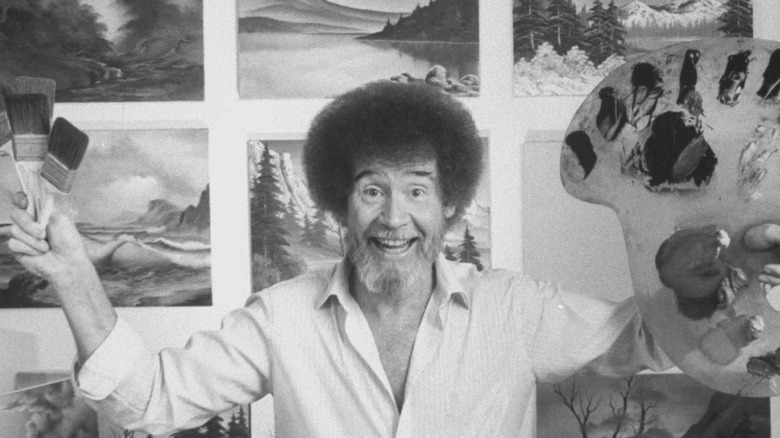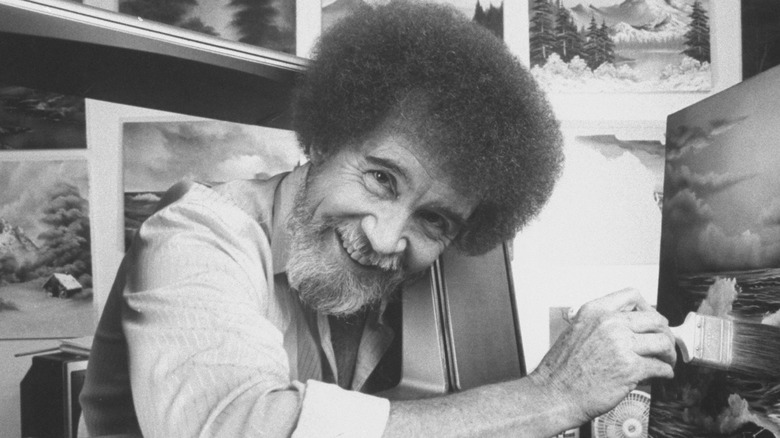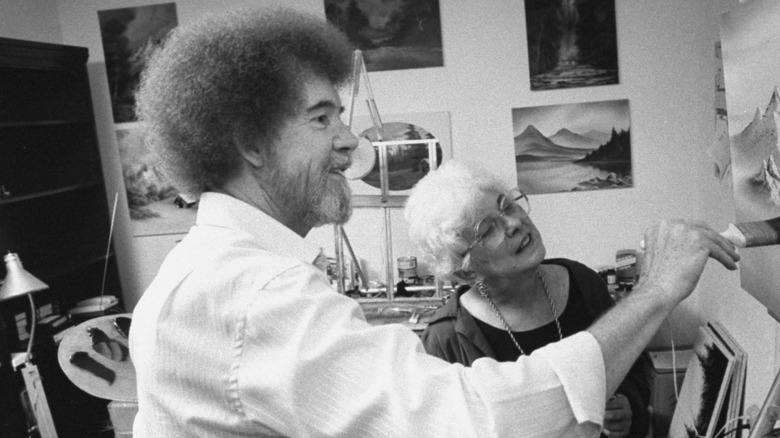The Tragedy Of Bob Ross Explained
Quite possibly the calmest, most peaceful human being to ever grace the small screen, public television instructional painter Bob Ross surprisingly lived a life that was often upended with pain, heartbreak, health problems, and legal battles. Perhaps his defiantly chilled out, warm, and friendly demeanor was a response to all the negative things and tragedies Ross experienced, and each mountain, cloud, forest creature, and "happy little tree" he brought to life on "The Joy of Painting" throughout the 1980s and 1990s was an act of peace against a nasty world.
On his show "The Joy of Painting," Bob Ross made painting an original work of art from scratch, right off of the top of his bushy-hair-covered head, look very easy. But life wasn't easy for the man who inspired countless viewers to pick up a paintbrush and give artistic expression a try, which is a powerful legacy indeed. While many respected artists were terrible people, Ross simply had terrible things happen to him. Here's a look into the little-seen dark side of PBS superstar Bob Ross.
Bob Ross had a rough youth full of divorce, injury, and death
Bob Ross was born in 1942 and raised in the Orlando, Florida, area. His parents split up early in Ross's life, filing for divorce when the future artist was just around a year and a half old. Both of his parents remarried and while Ross was raised primarily by his mother, he kept communication lines open with his father, carpenter Jack Ross, who hired his son to work for him.
Ross needed to go to work for multiple reasons — he ended his education after dropping out during his freshman year of high school, and around that time, he became an unmarried teenage father. It was during this early period of Ross' employment with his father that he severed and lost part of his finger in a woodcutting accident. When he was a young adult, Ross's parents divorced their present spouses and married each other once again, just before Jack Ross died at the relatively young age of 50.
The harshness of military life changed Bob Ross
What was Bob Ross like before the fame? You may be surprised to hear that he was in the military. In the early 1960s, Bob Ross joined the U.S. Air Force, and he departed Florida to an assigned post in Alaska. The natural landscapes of the state inspired Ross's desire to make art, so he painted during his downtime and sold his works to local gift shops.
His earnings from art soon exceeded his Air Force salary, which allowed him to plan for his post-military future, and for Ross, that couldn't come soon enough. In the Air Force, Ross served as a first sergeant, an authoritative position that needed a certain temperament. "I was the guy who makes you scrub the latrine, the guy who makes you make your bed, the guy who screams at you for being late to work," he told the Orlando Sentinel. "The job requires you to be a mean, tough person. And I was fed up with it."
Ross made a promise to himself: If and when he retired from the military, he'd henceforth never shout or raise his voice. In 1981, after 20 years of service, he left the Air Force, and made sure to keep his pact. And that personal stand against the harshness of military life inspired Ross's uniquely soft-spoken, whisper-adjacent method of speech on "The Joy of Painting."
Bob Ross's marriages ended in divorce and death
During his period of service in the U.S. Air Force in the 1960s, Bob Ross met and subsequently married a woman named Vicky (or Vivian) Ridge. Becoming a part of the sometimes tragic history of divorce, the two split — reportedly due to infidelity on Ross's part — and then concocted a unique, family-splitting custody agreement pertaining to the two sons they shard, Bob Jr. (from a previous relationship when Ross was a teenager) and Steven. Bob Ross would raise Steven in Alaska, and his former wife, living in Florida, would be responsible for Bob Jr.
While still living in Fairbanks, Alaska, in the 1980s, Bob Ross met a U.S. Department of Defense employee and painter of flowers named Jane. They married in the 1980s and remained together until the early 1990s, when Ross suffered two profound losses in rapid succession. His mother, Ollie Ross died at the age of 71 in 1991, and in 1992, so did his wife Jane. The latter's cause of death was cancer.
Bob Ross had numerous health issues
Bob Ross began hosting "The Joy of Painting" in 1983, the same year he'd experience the first in a series of medical problems. Ross was diagnosed with recurring cluster headaches so severe that he'd eventually need hospitalization. The voracious smoker also survived a heart attack in 1986, and then received a cancer diagnosis, for which he received treatment and recovered. Nevertheless, Ross reportedly grew resigned to what he thought was his fate to die at a relatively young age.
The cancer would return in the early weeks of 1994 in the form of lymphoma, which affects the lymphatic system, part of the body's network of immunity defenses. Despite a small chance of recovery, Ross submitted to physically taxing anti-cancer chemotherapy and radiation treatments, which led to the loss of his famously towering curly hair; he wore a wig when taping what would be his final episodes of "The Joy of Painting." The tragic death of Bob Ross from cancer occurred on July 4, 1995. Sadly fulfilling his own ominous premonition, Ross was only 52 years old
In the last 12 months of his life, Ross appeared in the first episode of "The Adventures of Elmer and Friends." It centered on Elmer, a "happy little tree" like so many described on Ross's "The Joy of Painting." Ross's final work, it taped before his 1995 death, but didn't air until 1996, along with a dedication to the painter at the end of the episode.
His family and company fought over his estate
Entrepreneurs Walt and Annette Kowalski discovered aspiring painter Bob Ross in the early 1980s, offering to house and feed him if he taught painting classes they'd arrange. That led to an Indiana public TV affiliate launching Ross's "The Joy of Painting" in 1983, soon syndicated to more than 200 other stations, and so Ross and the Kowalskis formed Bob Ross Inc. to manage the series and a spinoff line of art supplies. As Ross's celebrity grew, he attempted some brand extensions on his own, which irked the Kowalskis, as did an unfavorable shift in Bob Ross Inc. ownership shares in 1992 after the death of Ross's wife and stakeholder, Jane Ross.
As Ross's death approached in 1995, Walt Kowalski pushed him to sign a contract that would grant rights over all his work in perpetuity in exchange for a 1% profit share for 10 years. Ross wouldn't sign and then rewrote his will, excluding the Kowalskis and leaving control of his name, image, and work to his son Steve and half-brother Jimmie Cox. Ross additionally removed Annette Kowalski as the executor of his estate in favor of his wife, whom he'd married a few weeks earlier.
Nevertheless, the Kowalskis sued for control of the Ross estate and won, leading to a flood of Ross-branded merchandise. Ross's intended heir, his son Steve Ross, sued for control in 2017, but lost the case.





